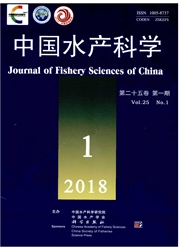

 中文摘要:
中文摘要:
以酪蛋白和明胶为蛋白源配制5组等氮等能的实验饲料,分别为全鱼油(F1)、25%(F2)、50%(F3)和75%(F4)豆油替代组和全豆油组(F5),每组4个重复,投喂初始体质量为(0.27±0.03) g的中华绒螯蟹(Eriocheir sinensis)幼蟹6周,评价豆油替代鱼油的饲料对幼蟹生长、非特异性免疫力和抗病力的影响。结果发现,各组幼蟹的存活率差异不显著(>0.05); F4组幼蟹的增重率和特定生长率显著高于F1组(<0.05),但与其他各组差异不显著(>0.05)。F4组幼蟹的血清酸性磷酸酶和碱性磷酸酶活性均显著高于其他各组(<0.05), F5组最低。幼蟹的血清中超氧化物歧化酶活性以F4组最高,显著高于F3组(<0.05), F3和F4组均显著高于其他各组(<0.05),其他F1、F2和F5三组间差异不显著(>0.05)。F1组幼蟹的血清丙二醛含量最高(<0.05),其余各组之间则差异不显著(>0.05); F4组幼蟹的血清酚氧化酶活性最高,而F5组最低(<0.05);各组幼蟹的溶菌酶差异不显著(>0.05)。实验结束后,采用嗜水气单胞菌(Aeromonas hydrophila)攻毒10 d,发现F5组幼蟹最早出现死亡,且该组幼蟹的累积死亡率显著高于F1和F4组(<0.05)。结果提示,采用豆油完全替代饲料中的鱼油对幼蟹的生长影响不显著,但会降低其抵抗感染疾病的能力;用75%豆油替代鱼油可在明显提高幼蟹免疫机能和抗病力的情况下获得良好的生长性能。
 英文摘要:
英文摘要:
Traditionally, fish oil is the main lipid source in the feed for most species in aquaculture owing to its effective supply of energy and high content of essential fatty acid. The fatty acid especially n-3 HUFA from the fish oil had also been proved to have positive effect on maintaining the immune system. However, the decline of fish oil production from wild fisheries has resulted in a supply shortage and price escalation of fish oil. Therefore, it has been a major challenge to find viable sources of oil to substitute fish oil. Among available vegetable oils, soybean oil has been widely chosen due to its availability, price and abundant content of fatty acid. In this study, we evaluated the effects of diets with different fish oil and soybean oil ratios on grouth, non-specific immune response and disease resistance in Chinese mitten crab (Eriocheir sinensis). Five isonitrogenous and isoenergetic diets were for-mulated in which 0%(control:F1), 25%, 50%, 75%, or 100%(F2-F5) of the fish oil was replaced with soybean oil. Juvenile crabs (mean weight 0.27±0.03 g) were assigned to one of five treatment groups (four replicates per group) and fed one of the diets for 42 d. There was no significant difference in the survival rate among the treatments (〉0.05). The weight gain was significantly higher in the F4 group than in the F1 group (〈0.05). Similarly, the crabs in the F4 group had significantly higher serum ACP (acid phosphatase), AKP (alkaline phosphatase), and serum SOD (superoxide dismutase) activities than the other treatment groups (〈0.05). F4 and F3 group were significantly higher than the other groups (〈0.05). Serum MDA (malondialdehyde) content was significantly higher in the F1 group than in the other groups, but there was no difference between the other groups (〉0.05). Serum PO (phenoloxidase) activity was higher in F4 and lower in F5 than the other groups (〈0.05). There was no difference in serum lysozyme activity among the
 同期刊论文项目
同期刊论文项目
 同项目期刊论文
同项目期刊论文
 Growth performance, antioxidant status and immune response in darkbarbel catfish Pelteobagrus vachel
Growth performance, antioxidant status and immune response in darkbarbel catfish Pelteobagrus vachel Partial or complete substitution of fish meal with soybean meal and cottonseed meal in Chinese mitte
Partial or complete substitution of fish meal with soybean meal and cottonseed meal in Chinese mitte Partial or Total Replacement of Soybean Meal by Cottonseed Meal in Practical Diets for Chinese Mitte
Partial or Total Replacement of Soybean Meal by Cottonseed Meal in Practical Diets for Chinese Mitte Dietary vitamin B-12 requirement and its effect on non-specific immunity and disease resistance in j
Dietary vitamin B-12 requirement and its effect on non-specific immunity and disease resistance in j Effect of dietary copper on the growth performance, non-specific immunity and resistance to Aeromona
Effect of dietary copper on the growth performance, non-specific immunity and resistance to Aeromona Molecular cloning, characterization and mRNA expression of copper-binding protein hemocyanin subunit
Molecular cloning, characterization and mRNA expression of copper-binding protein hemocyanin subunit Effects of ammonia stress, dietary linseed oil and Edwardsiella ictaluri challenge on juvenile darkb
Effects of ammonia stress, dietary linseed oil and Edwardsiella ictaluri challenge on juvenile darkb Molecular characterization of cathepsin L cDNA and its expression during oogenesis and embryogenesis
Molecular characterization of cathepsin L cDNA and its expression during oogenesis and embryogenesis EFFECT OF COPPER-ENRICHED ARTEMIA ON GROWTH, BODY COMPOSITION, ANTIOXIDANT ENZYME ACTIVITIES, AND OS
EFFECT OF COPPER-ENRICHED ARTEMIA ON GROWTH, BODY COMPOSITION, ANTIOXIDANT ENZYME ACTIVITIES, AND OS Effect of oxidized fish oil and α-tocopherol on growth, antioxidation status, serum immune enzyme ac
Effect of oxidized fish oil and α-tocopherol on growth, antioxidation status, serum immune enzyme ac Effects of dietary folic acid on growth, antioxidant capacity, non-specific immune response and dise
Effects of dietary folic acid on growth, antioxidant capacity, non-specific immune response and dise Molecular characterization of a cytosolic manganese superoxide dismutase from the Chinese mitten cra
Molecular characterization of a cytosolic manganese superoxide dismutase from the Chinese mitten cra Effect of dietary lipids and vitamin E on growth performance, body composition, anti-oxidative abili
Effect of dietary lipids and vitamin E on growth performance, body composition, anti-oxidative abili Growth and immune response of Chinese mitten crab (Eriocheir sinensis) fed diets containing differen
Growth and immune response of Chinese mitten crab (Eriocheir sinensis) fed diets containing differen 期刊信息
期刊信息
